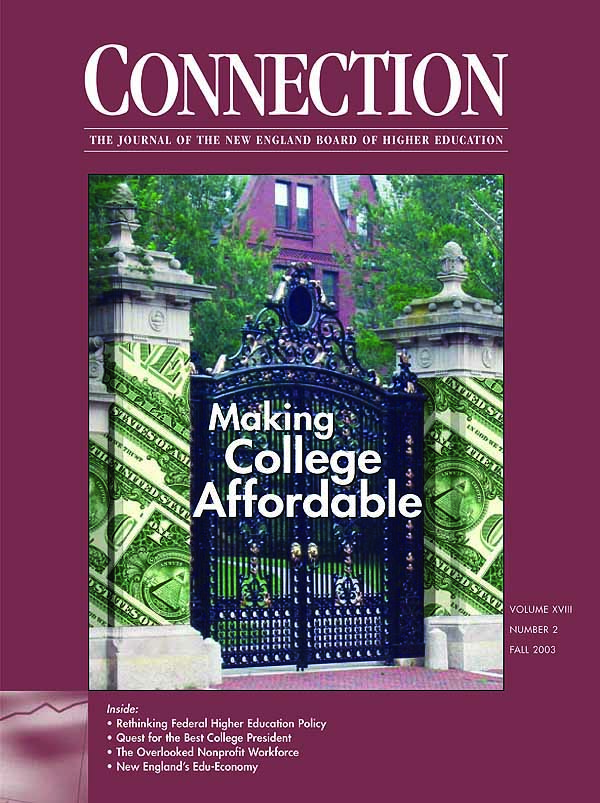
Click the cover image to view and download this issue in PDF format.
Fall 2003
For more information, contact:
John O. Harney, Executive Editor, Connection
617.357.9620
email: connection@nebhe.org
New England Board of Higher Education Journal Connection Outlines Policies to Make College Affordable
BOSTON — State and federal agencies and colleges and universities could adopt a range of policies and practices to make college more affordable, according to articles in the Fall 2003 issue of Connection: The Journal of the New England Board of Higher Education.
Following is a summary of articles that appear in the Fall 2003 Connection:
Making College Affordable — Large numbers of lower-income students are being priced out of college. Those who do attend often take on major student loan debt or work long hours, compromising their academic performance. But there are ways for states and institutions to make a college education more affordable. Ann Coles, senior vice president of The Education Resources Institute and director of the national Pathways to College Network, explains how innovative partnerships and incentive systems can reduce college costs É without big new infusions of resources.
Federal Triangle — Congress is getting set to reauthorize the landmark Higher Education Act of 1965 for the eighth time. In the first of a two-part Connection series on reauthorization, American Council on Education Vice President of Government Relations Terry Hartle and Assistant Director of Government Relations Chris Simmons offer an inside look at which issues will be on the table and deliver a warning to campuses: “If the landmark No Child Left Behind law enacted in 2001 is a guide, the possibility of inappropriate intervention is greater this time around than it has been in past reauthorizations,” warn Hartle and Simmons. “The NCLB precedent suggests that some federal policymakers are perfectly willing to bring Washington’s heavy hand to the college campus.”
Earn, Learn . . .Serve? — The nearly 40-year-old Federal Work-Study program helps more than 70,000 New Englanders pay for college each year, and in many cases, provides invaluable work experience. With consensus emerging that integrating work experience with academics is a key workforce development strategy, one might think this Great Society program would be riding high. Instead, lawmakers in Washington are level-funding the program and questioning its mission. Journalist Abbey Marzick explains.
Sticking It to Students — Thanks to some quiet accounting this past spring by the Bush administration, financially strapped families across the country could find themselves suddenly ineligible for federal student aid. Chuck OÕToole of the New England Board of Higher Education explains a controversial proposal to increase the so-called Expected Family ContributionÑthe complicated government formula used to determine aid eligibility.
An Integrated Approach to Affordability — NEBHE President Robert A. Weygand calls on states to integrate currently disconnected policies governing state support of public higher education, tuition and fees and state-provided need-based student aid. Most New England states have failed to increase funding of need-based student scholarships at even close to the rate that their public college tuition and fees have increased, Weygand writes. Meanwhile, tuition discounting and increasingly popular merit-based aid programs may direct aid away from the students who need it most.
Searching Highs and Lows — College presidents are serving significantly shorter terms than they once did. Boston Business Journal higher education reporter Sheri Qualters examines the complex challenges colleges face in finding the best presidents. “When people start thinking about doing a search, they think about doing it backwards,” one executive search consultant tells Qualters. “They think about who are we going to get rather than thinking about the agenda.”
New EnglandÕs Overlooked Nonprofit Workforce — Nearly two-thirds of nonprofit CEOs are in the job for the first time. And fewer than half say they plan to take on a nonprofit CEO role again. David Garvey, director of marketing of the University of ConnecticutÕs College of Continuing Studies, and Stephen Pratt, executive director of Eureka-Boston, explain how lack of attention to the nonprofit sectorÕs workforce development and management capacity needs reduces the social and economic return on New EnglandÕs annual $68 billion investment in the vital sector.
The Edu-Economy — New EnglandÕs private colleges and universities employ 190,000 peopleÑand they kept adding jobs right through the recent recession. University of New Hampshire economist and New England Economic Project Vice President Ross Gittell reports on the regionÕs relatively robust higher education job sector.
Books — Theodora Kalilkow, president of the University of Maine at Farmington, reviews University of Michigan President James J. Duderstadt and Chief Financial Officer Farris W. WomackÕs new book on the future of the public university. Freelance writer Alan Earls reviews a new history of Digital Equipment Corp.
[ssba]
